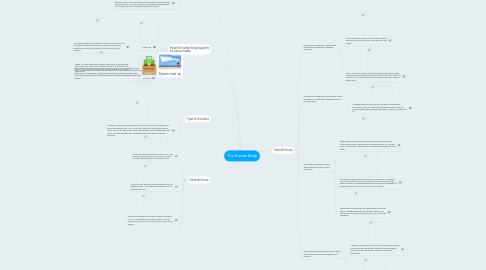
1. Dynamic load
1.1. Our body has to deal with dynamic loads like wind, rain and snow on a daily basis. The human body is very flexible and is able to do certain things to avoid getting hurt. For example, if there is a strong wind blowing and the body might fall, the body can immediately lower it's center of gravity by spreading it's legs.
2. External forces
2.1. Wind is an external force that acts on our body on a daily basis. External forces act from the outside. Therefore this is an external force
2.2. Snow and rain are external forces that act on our bodies as well. This is because it exerts a force outside our body.
2.3. Gravity is an external force that is always acting on us. It is a force that pulls down on object. It is an external force because it acts on thee outside of our bodies.
3. Type of structure
3.1. Our body is a frame structure because frame structures are made up of structural components. In our case, the structural components are our bones. There can also be an object covering the frame (a sheet, skin etc.) and in our case we have skin. Therefore, the human body is a frame structure.
4. How the human body supports its various loads.
4.1. Dead load
4.1.1. The human body`s main support is the legs. This is because our legs are what we stand on. Our center of gravity in anatomical position lies anterior to the second sacral vertebra.
4.2. Live load
4.2.1. When our body supports an object, the object is the live load. This is because a live load is a variable load on a structure. Our body is the structure and the live load is the object our body is supporting.
5. Function
5.1. The function of the human body is to help us stay alive. The function of our limbs are to keep us moving and to hold objects. The function of our lungs is to help us breathe and the function of our heart is to pump blood throughout our body.
6. Internal forces
6.1. Our skeletons experience shear when turning or being pulled in opposite directions
6.1.1. Turning: This girl's body is under shear because when her feet pull her to one side, her body has follow
6.1.2. Skater doing lift: This girl's body is under shear because when one part her body goes one way, the other part tries to stay still but the force of staying still isn't strong enough so her body is under shear.
6.2. Our skeletons experience compression when being put in a tight area or when we are in a crowded place
6.2.1. Crowded stadium: these people are under compression because on order to be able to see the performer, they are pressing their bodies against each other so that all of them can fit
6.3. Our bodies experience tension when being pulled on or when stretching
6.3.1. These people in the elevator are being compressed because most of the space in the elevator is being taken up. So, in order to fit in the elevator, their bodies are being pressed against each other.
6.3.2. Our bodies being pulled on: Tension is a pulling force. the hand on top of the picture is pulling the hand at the bottom and the hand at the top is experiencing tension because of the weight it is holding therefore, tension is at work on both arms.
6.3.3. Stretching: This girl's legs are under tension because she has straightened them to the toes. Tension is a pulling force and she is pulling on her legs to become straighter.
6.4. Our bodies experience torsion when we do activities like dancing and when we are twisting
6.4.1. Twisting: When this man has his toes facing the wall and his upper body facing the camera, his hips are under torsion because his body is rotating in opposite directions.
6.4.2. Dance: This man's feet and pointing to one side and his body to another. Since torsion is the opposite rotational force, this man's hips are under torsion.

